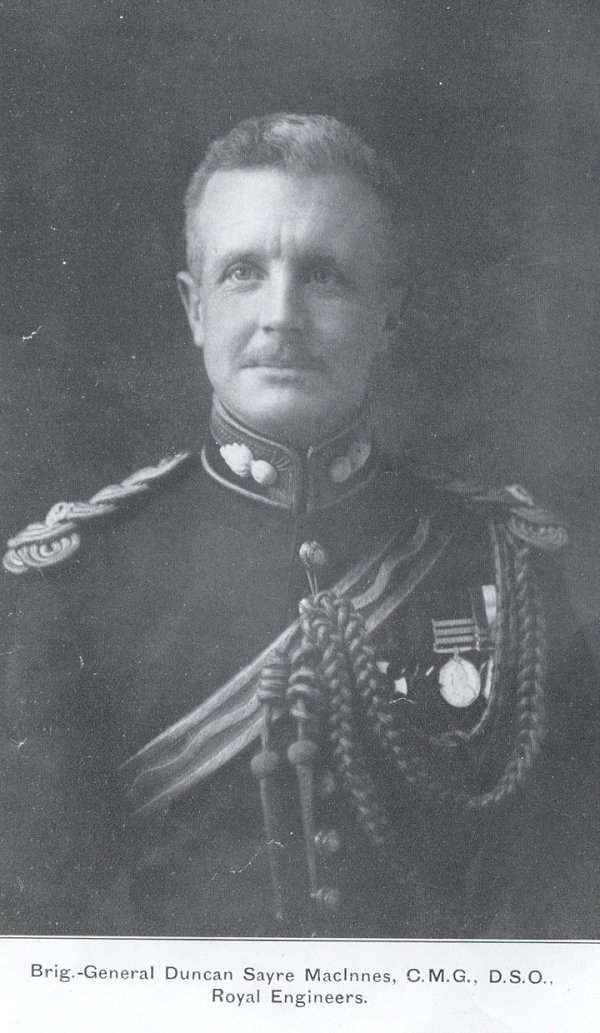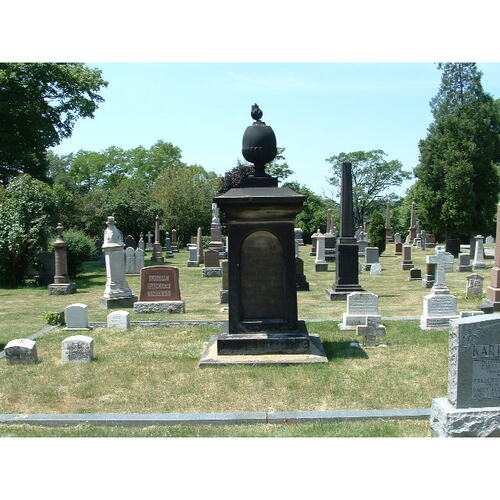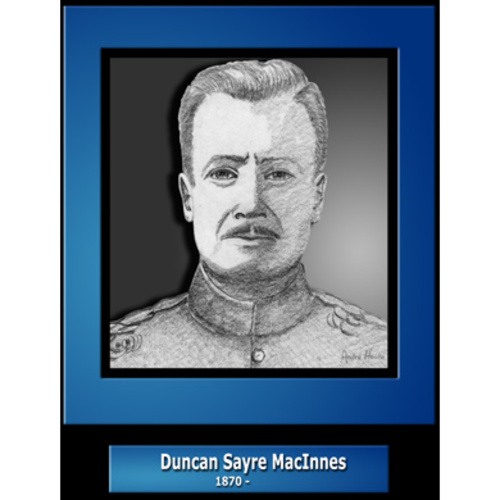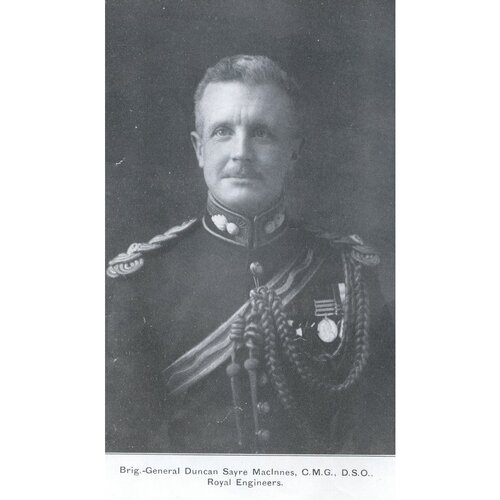
Source: Link
MacINNES, DUNCAN SAYRE, army officer; b. 19 July 1870 in Hamilton, Ont., son of Donald McInnes* and Mary Amelia Robinson; m. 22 Oct. 1902 May Millicent Wolferstan Thomas in Montreal, and they had at least one daughter and one son; d. 23 May 1918 on the Western Front.
Duncan MacInnes was educated at Trinity College School in Port Hope, Ont., before entering the Royal Military College of Canada at Kingston in 1887. He graduated with distinction four years later and was commissioned a second lieutenant in the Royal Engineers on 16 July 1891. MacInnes, intent on a career in the British forces, was one of those Canadians whose importance would emerge in the imperial context.
Promoted lieutenant on 18 July 1894, he served in the Ashanti expedition of 1895–96; his later work in erecting a fort at the Ashanti capital of Kumasi (Ghana), an obituary noted, “reflected great credit upon him.” He served throughout the South African War and “worked out most carefully and constructed with marked ability and success, the Engineer operations for the defence of Kimberley.” At the same time he was principal staff officer to Lieutenant-Colonel Robert George Kekewich, who commanded the garrison during the siege of the town. Between May and November 1900 MacInnes was engaged in field operations in the Orange River Colony. For his work in the war he was admitted to the Distinguished Service Order.
In 1902 MacInnes married Millicent, younger daughter of the late Francis Wolferstan Thomas, a prominent Montreal banker. He then returned to the Cape Colony as assistant director of works to the fledgling South African Constabulary. Occasionally his Canadian origins would show; in 1904, for instance, he and other Canadians, among them Samuel Benfield Steele, celebrated Dominion Day at a banquet in Johannesburg. Between 1905 and 1908 he served in Canada with the local rank of major, first as deputy assistant quartermaster general at Halifax. In this post he performed much of the work involved in turning over the fortress and garrison to Canada in 1906. From September 1907 he was deputy assistant adjutant-general, Maritime provinces, until he was recalled to England on 31 March 1908 to attend the Staff College at Camberley.
In 1910 MacInnes was gazetted a general staff officer in the Directorate of Military Training at the War Office, where, according to his obituary in the Royal Engineers Journal, he “played an important part in the reorganization of the Army Signal Service.” Early in 1912 he became secretary to an advisory committee on military aviation of the Committee of Imperial Defence. Its recommendations provided the basis for the white paper that led to the establishment in April of the Royal Flying Corps, initially “an aeronautical service for naval and military purposes.” In the face of general scepticism and lack of interest at the War Office, MacInnes’s “help was unremitting and of immense value,” recalled Frederick Hugh Sykes, the first commander of the military wing of the RFC.
In 1913 MacInnes was posted to the staff at Camberley, where he remained until the outbreak of World War I in August 1914. He then went to France in command of a field company of Royal Engineers, participated in the retreat from Mons, and in November received a wound which permanently restricted the use of fingers on his right hand.
Promoted brevet lieutenant-colonel on 29 Nov. 1915, MacInnes went back to the War Office as assistant director of military aeronautics. William Sefton Brancker, the director, would later record that he had “never met another man so devoted, so hard-working, so utterly self-sacrificing, and so loyal. . . . All our great output, wonderful workmanship and high efficiency in performance obtained towards the end of the war can ultimately be put down to his work.” In March–April 1916 the Directorate of Military Aeronautics was reorganized into three sub-directorates. MacInnes was appointed director of aircraft equipment, in charge of design, supply, and maintenance, and subsequently made a temporary brigadier-general. Faced with extraordinary demands for more and better aircraft, an overwhelmed system of procurement, and malicious attacks from such superiors as RFC commander Hugh Montague Trenchard, an overworked MacInnes suffered a breakdown in the fall of 1916 and he left the directorate that winter. Retiring by nature and uninterested in honours, he was rewarded with a cmg on 1 Jan. 1917.
In March, in a move that involved relinquishing his temporary rank, he went back to the Western Front to become commanding Royal Engineer to the 42nd Division, in the substantive rank of lieutenant-colonel. In January 1918 he was appointed inspector of mines at general headquarters in Montreuil, France, and restored to the rank of brigadier-general. MacInnes was accidently killed while visiting the front on 23 May 1918, possibly as a result of his work with mines, and he was buried at Étaples.
Obituaries, the memoirs of associates, and historians of British air policy all recognize the significance of MacInnes’s early contributions to the development of a British air force. According to Aeroplane in 1918, as director of aircraft equipment it had fallen to him “to evolve from the formless muddle of 1915 some regular scheme for organizing and increasing aircraft production simultaneously. . . . His name deserves to live in the history of Military Aeronautics as one of those who helped the R.F.C. out of its blackest days.”
Times (London), 25 May 1918. Aeroplane (London), 29 May 1918: 2022. Can., Dept. of Militia and Defence, Annual report (Ottawa), 1891: 111–16. Canadian men and women of the time (Morgan; 1912). Malcolm Cooper, The birth of independent air power: British air policy in the First World War (London, 1986). Encyclopaedia of Canadian biography . . . (3v., Montreal and Toronto, 1904–7), 2: 39. G.B., War Office, The monthly army list (London), January 1918: 789. Norman Macmillan, Sir Sefton Brancker (London and Toronto, 1935). J. H. Morrow, The Great War in the air: military aviation from 1909 to 1921 (Washington and London, 1993). Royal Engineers Journal (Chatham, Eng.), July 1918. F. [H.] Sykes, From many angles: an autobiography (London, 1942).
Cite This Article
Brereton Greenhous, “MacINNES, DUNCAN SAYRE,” in Dictionary of Canadian Biography, vol. 14, University of Toronto/Université Laval, 2003–, accessed December 12, 2025, https://www.biographi.ca/en/bio/macinnes_duncan_sayre_14E.html.
The citation above shows the format for footnotes and endnotes according to the Chicago manual of style (16th edition). Information to be used in other citation formats:
| Permalink: | https://www.biographi.ca/en/bio/macinnes_duncan_sayre_14E.html |
| Author of Article: | Brereton Greenhous |
| Title of Article: | MacINNES, DUNCAN SAYRE |
| Publication Name: | Dictionary of Canadian Biography, vol. 14 |
| Publisher: | University of Toronto/Université Laval |
| Year of publication: | 1998 |
| Year of revision: | 1998 |
| Access Date: | December 12, 2025 |






